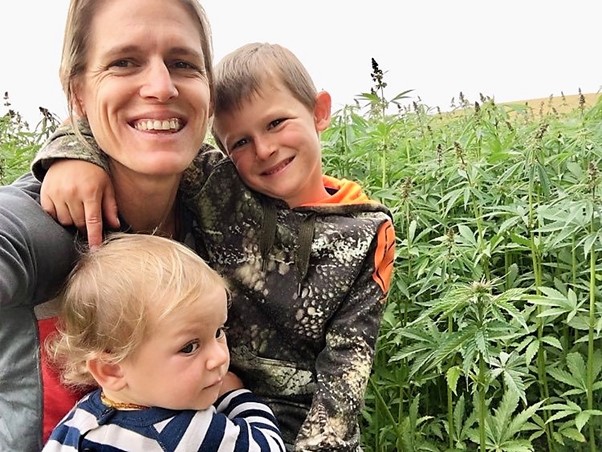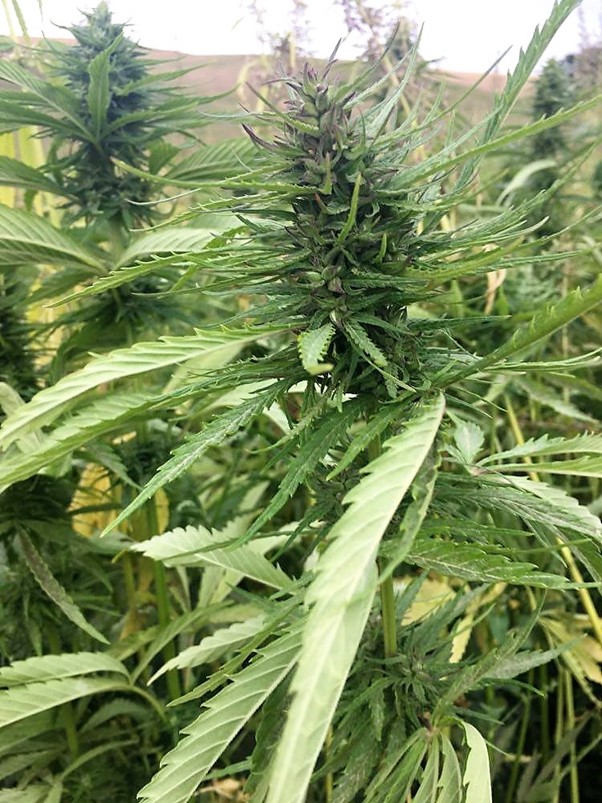
Our Commercial Hemp Growing Experience:
Simon & Kelly Cooney
My husband Simon Cooney, a Rural Bank Manager and I – Kelly Cooney, run Shangri-La Farm; a sheep and beef farm based out of Timaru in South Canterbury.
We have two young children who love their hemp smoothies! I am passionate about all things hemp, and chair the Media Committee for the NZHIA. We are first year growers of hemp as a dual crop, for both seed and fibre. Please read on to learn in detail all about our hemp growing experience… The good, the bad, and the ugly!
The land we were to plant our hemp on was full of weeds, and previously had cattle on it, in muddy conditions; we had to grub the area 3 times and then maxi tool it to level it out. We then pre-sprayed the paddock on 2nd October, 2019 with 4L of Glyphosate – Weedmaster + 25 grams /ha of Sharpen and Pulse. Unfortunately, we then had a bout of really cold and frosty weather, so we were delayed in our planting. Because of this we had to spray it out again, on the 18th November with another 4L Glyphosate, working it again, as the weeds had once more taken off and the soil had packed down with the wet weather we had been experiencing.
We planted out 3.9ha of land, in Hemp Seed cultivar CFX-2 on the 25th November, 2019. We planted at a rate of 25kg/ha. It took around 4 days to strike. It grew fast and was looking great. Then we hit a dry patch of weather, but the hemp was established by then and so continued to grow well for the conditions it was in. We harvested our hemp crop, 69 days from when it was planted – on the 2nd March, 2020.
Our crop was affected by birds, as we could see the ripe seed had been eaten off the tops. Being a small crop and with a row of trees on one side, it was easy takings for the birds.
As we are not cropping farmers, we didn’t have a harvester so were very grateful when our neighbour (who had also planted a hemp crop) agreed to harvest our crop also. From the epic failure stories we’d been told, the harvest of our seed was a success.
When harvesting for both the seed and the fibre, the fibre would get wrapped around the thrashing drum, but the key was that every hour you would go and cut it out to keep on top of it, and this worked really well. While harvesting, the combine would spit out balls of hemp fibre and we found that if the wind got into them, these balls would completely dry out, literally within hours of them being cut. This made it damn near impossible to windrow. We then learnt that it was really important to have the windrower come in right behind the combine for the fibre harvest, and windrow it before it dried out. For example, the windrower broke down on the neighbour’s block and so they came back to us the next morning and it was next to impossible to windrow after the crop… Lesson learnt… If the windrower breaks down STOP the combine!
We harvested 3,280kg of seed that day. After dressing the seed we got 1500kg of cleaned seed and 500kg of seconds (which is usually dumped, but they managed to get a contract on them).
The costs always play a large part as to whether we could do this again. And it was a big learning curve. Our costs are outlined below:
Costs of planting 4ha Hemp (+GST)
Licence $500
*Spraying $400
*Cultivation $2,000
Fertiliser $2,500
*Drilling hemp $600
*Direct drilling (re-grassing) $875
Seed 9x 25kg $2,300
Harvesting $1,300
Windrowing $680
THC Test – $500
Drying $763
Dressing $1,026
Transport $400 (drying to dressing)
Foundation Agricultural Research (FAR) levy deduction $60.75 (0.09% on your farm-gate revenue)
FAR levy deduction (seconds) $9.01
MD Purity Test $50
Total Cost: $13,964 + GST or $3,491/ha
*Please note – all spraying, cultivation and drilling is at contract rates.
Income from 4ha Hemp (+GST)
1500kg Hemp seed $6,750
308kg Hemp Seed – Seconds $1,001
Total Income: $7,751 + GST or $1,937 / ha
Nett Result: ($6,213)
NB: With our initial aim of growing a dual crop (fibre and seed) the above nett result could have been improved upon if we had sold our fibre. Unfortunately, however, our fibre did not meet contract specs, as it was full of a weed called Fathen, and so this was then burnt.
We would have received $500/mt baled, plus cost of baling.
Pros / Opportunities
- The opportunity lies in creating unique hemp product that is locally made.
- The opportunity in utilizing the whole plant. So that means leaf and the flower/buds which is all dependent on a change in the NZ regulatory environment.
- A hemp crop does well in a sheep and beef farming system because of the short growing time of 69 days, we were able to fatten sheep in the same paddock.
Cons / Challenges
- Securing a contract/ somebody to buy your product.
- Size: Little sustainable blocks are less sustainable because of contractors and birds.
- Profitability;
- Personally (after 10 years farming) the worst returning farming activity in our career. The real Cost of Hemp per hectare $3,491 / ha – to high / risky crop to be grown under dry land but even at this cost it is very marginal under irrigation – 1,000kg / ha = $4,500 / ha income = $1,000 per hectare EBIT
- Too many other people making money other than farmer.
- Biggest challenge is that there needs to be more money for farmer, in turn products are more expensive, and then you hit a price ceiling.
- Competition: Challenge is that NZ is competing with imported organic hemp seed and oil that is cheaper than NZ prices.
- Environment: Weather, which delayed our planting and meant another pre-spray.
- Dealing with Ministry of Health (MOH): TIP: Make sure you get your application in early as it is a very slow process dealing with the MOH. From initial application received, it took 5 months for us to receive our licence.

We learnt a lot growing hemp. It also cost us a lot. We love hemp as a plant and the benefits it provides both to the land and the people and also the huge scope it has in the marketplace. It is partly up to Kiwi ingenuity to make this one fly. Regulatory conditions also play a huge role, they need to change so that we can commercially use the whole plant, creating more revenue streams.
Even if we wanted to try and recoup costs by growing again this year, we didn’t stand a chance. As an unirrigated block we do not meet this year’s specs for a contract.
Are you thinking of growing hemp? Have you been growing hemp? Do you have any thoughts/ feedback/ advice to give us after reading the above?…
We’d love to hear! Email to kelly@wildfiresolutions.co.nz
(Image: Approved cultivar CFX 2 – 2019/2020 season)
